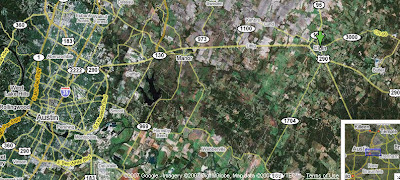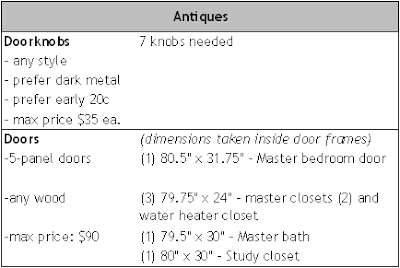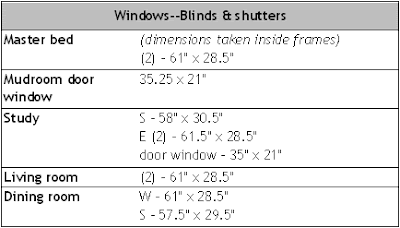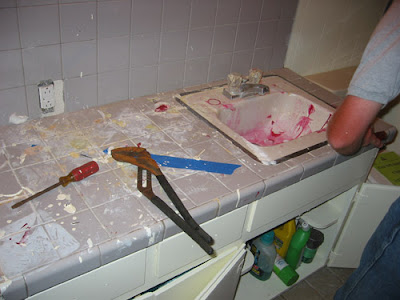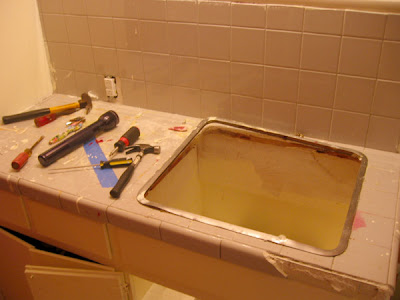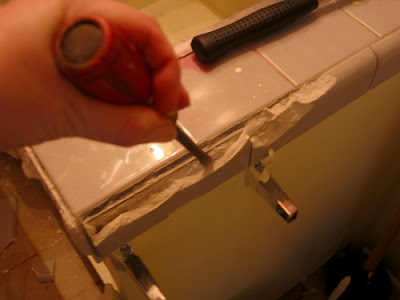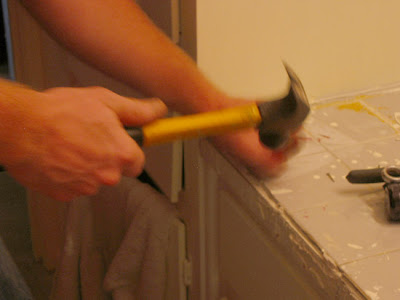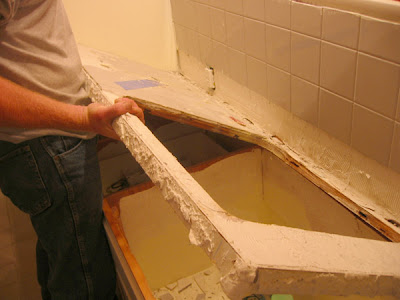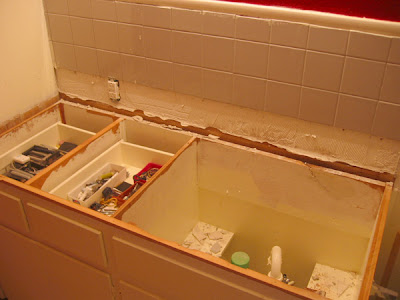Proud to be the Brick Capital of the Southwest
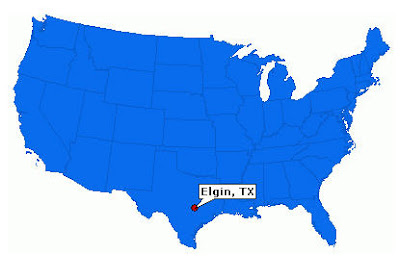 I thought we'd take a break from the usual around here and do a little profile of Elgin, Tx.
I thought we'd take a break from the usual around here and do a little profile of Elgin, Tx.First of all, its location:
It's about 20 mi. east of Austin on Hwy 290, past the wildly proliferating suburb of Manor. (That's "MAY-ner," not "Manner" for you out-of-towners. And, while we're on the subject, it's "EL-ghin," not "EL-jin," which is east of "BURN-it" not "Burn-ET" and north of "BARE" not "Bex-ar" County. That's just how it is.)
History
The Handbook of Texas Online says that the town of Elgin was founded in 1871 by the railroad a few miles up the road from the settlement of Hogeye, Texas, (also known, less colorfully, as Perryville), which it subsequently absorbed. The town's Hogeyean roots, however, are recalled in Elgin's annual Hogeye Festival, which, to the relief of all concerned, does not involve eating any hog's eyes whatsoever. The new town was initially named "Glasscock" until someone thought the better of it and named it after a Poobah of the railroad company, one Robert Morris Elgin.
According to the Elgin Chamber of Commerce, the railroad was originally supposed to run through McDade, now a modest hamlet to the east of Elgin, but was somehow deterred by a big flood.
By 1884 Elgin had its first brick manufactory, as well as a broom factory, cotton processing, and the beginings of a profitable coal mining industry. The Elgin Courier, founded in the 1800s, is still in print. The one brick plant eventually swelled to three, and they remain in operation today. However, somewhere along the way Elgin opted to base its claim to fame on its sausage rather than its bricks and changed its slogan from "The brick capital of the southwest" to "The sausage capital of Texas." Two popular BBQ joints (Meyer's and Southside) still export competing lines of sausage to the rest of the state, with an annual combined production of 3 million pounds, according to the Elgin CoC.
Nevertheless, as a happy result of the large Hispanic population in town, your best bet for eats may well be Mexican. The strength of the margaritas at El Maguey has to be measured on the richter scale, and they boast excellent, toasty, flavorful tortillas as well. (Our realtor warned us against this restaurant, albeit in vague terms. After a few sips of your margarita, however, you won't care--or notice--if they're serving you grilled Chihuahua--it's just darn tasty). Guadalupe, on 290, is also a solid choice.
Current Elgin Stats
The City of Elgin also has a website. Among other things, they list Elgin's three annual festivals: Western Days, The Hogeye Festival, and the Chilepepper Festival.
Their community plan ("Envision Elgin") includes efforts to improve the mediocre ranking of the school system, to preserve and enhance the delightful historic downtown, and to promote regionalism (which seems to mean looking for cooperative solutions to regional infrastructure issues).
(The chart below, from trulia.com, gives some sense of how Elgin schools are doing.)
 On a related note, city-data.com graphed the results of the 2004 presidential election. Correlation? You decide.
On a related note, city-data.com graphed the results of the 2004 presidential election. Correlation? You decide. Trulia also gives a handy table of Elgin's financial stats. To be fair to Elgin, while it is below both Texas and national averages, it isn't very far below--it's easy to misread the graphic below and think that we're practically a 3rd world country. We're actually just a little south of average.
Trulia also gives a handy table of Elgin's financial stats. To be fair to Elgin, while it is below both Texas and national averages, it isn't very far below--it's easy to misread the graphic below and think that we're practically a 3rd world country. We're actually just a little south of average....and now for some good news. Elgin has very low crime rates both compared to its county and to the state as a whole. We may not be rich or brilliant, but we're honest, darnit. And safe, which, joking aside, is a valuable asset.
(By the way, if you have trouble reading the charts, click on them to see a large version.)
Trulia also shows the breakdown of home age in Elgin. How you feel about this stat probably depends on your perspective, but I think it's GREAT. We have a higher percentage of old houses (i.e., built before 1950) than the county or the state. Which is why, unlike Manor, Elgin has a lovely old town feel. And it's why Matt & I were able to buy our ducky little 1910-20 house. It's also why we wanted to move to Elgin as soon as we saw it.
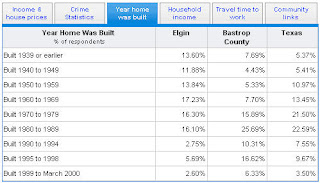 Elgin has lots of delightful older homes
Elgin has lots of delightful older homesWe can also learn a little about the ethnic background in Elgin from epodunk.com. Keep in mind that one person can have multiple ancestries--the numbers won't necessarily add up to 100.
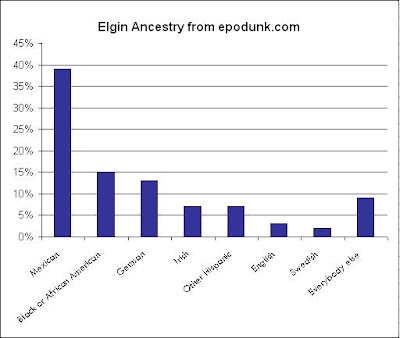
For an even more thorough exploration of available data, there is city-data.com. It tells us, for example, that Elgin is 4.7 square miles, with an average of 1,852 people per square mile, which is considered fairly low.
In addition, city-data has some very nice climate charts. The long and the short: it's hot and humid here. I can tell you from personal experience, however, that it is moister than Austin--the trees in old town Elgin are much taller and more robust than trees in Austin.

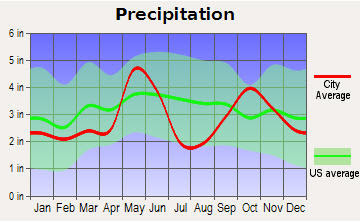
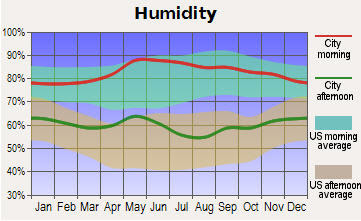
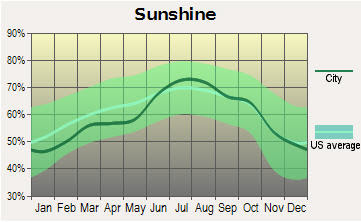
 Real Estate Issues
Real Estate IssuesEh. We're not doing so hot. Mind, that's why Matt & I were able to afford Elgin in the first place, but we didn't want the prices to continue to decline, as indicated in this chart from Altosresearch.com.
 On the bright side, according to trulia's data, the price falloff is really confined to very high end houses--$600K or more. On our more modest end of the scale, there is only a tiny decline. And hey, that means lower taxes anyway, right?
On the bright side, according to trulia's data, the price falloff is really confined to very high end houses--$600K or more. On our more modest end of the scale, there is only a tiny decline. And hey, that means lower taxes anyway, right?
The data below is just pitiful--from 10 to 50 days on market in a month?? There aren't even 50 days in a month! Are we selling in some sort of time warp? I suppose what's likelier is that the quantity of homes sold in Elgin is so low that it's easy to send the numbers into precipitous declines and equally dramatic elevations.
 On the other hand, while overall home prices have declined, price per square foot has slightly... increased? Does that even make sense?
On the other hand, while overall home prices have declined, price per square foot has slightly... increased? Does that even make sense?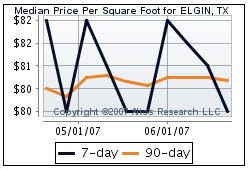
And finally, here's trulia's more explicit breakdown of home values in Elgin--bear in mind that these are asking prices only--not selling prices. 2-bedrooms have absolutely nose-dived. But 3- & 4-bedrooms are enjoying a slight increase. What the hell? Once again, my special little demographic (we have three bedrooms here at the hacienda, thank you very much) isn't the one in trouble, but I do think it's peculiar all the same.

On a further real estatey note, the City of Elgin site also pointed out that Elgin is the fastest growing city in Bastrop County:
1850 single family lots platted
3340 single family lots conceptual
176 duplexes platted
So I don't suppose those home values will be bouncing back any time soon. We weren't planning on moving anyway, and any return is a better investment than the renting we had been doing throughout our 20s, so I'm not too despondent.
Next in the series: the coolness of downtown Elgin, and definitive proof that we're miles worthier than our competition for Austin ex-pats and retail outlets, Manor.

